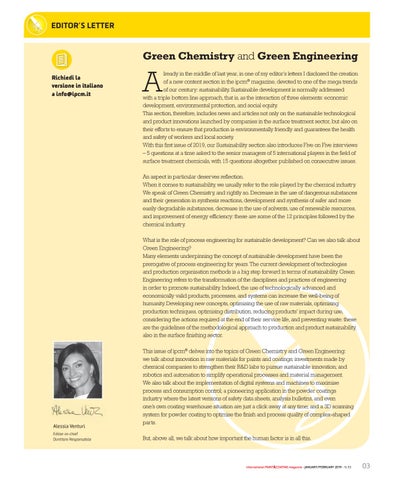EDITOR’S LETTER
Green Chemistry and Green Engineering Richiedi la versione in italiano a info@ipcm.it
A
lready in the middle of last year, in one of my editor’s letters I disclosed the creation of a new content section in the ipcm® magazine, devoted to one of the mega trends of our century: sustainability. Sustainable development is normally addressed with a triple bottom line approach, that is, as the interaction of three elements: economic development, environmental protection, and social equity. This section, therefore, includes news and articles not only on the sustainable technological and product innovations launched by companies in the surface treatment sector, but also on their efforts to ensure that production is environmentally friendly and guarantees the health and safety of workers and local society. With this first issue of 2019, our Sustainability section also introduces Five on Five interviews – 5 questions at a time asked to the senior managers of 5 international players in the field of surface treatment chemicals, with 15 questions altogether published on consecutive issues. An aspect in particular deserves reflection. When it comes to sustainability, we usually refer to the role played by the chemical industry. We speak of Green Chemistry, and rightly so. Decrease in the use of dangerous substances and their generation in synthesis reactions, development and synthesis of safer and more easily degradable substances, decrease in the use of solvents, use of renewable resources, and improvement of energy efficiency: these are some of the 12 principles followed by the chemical industry. What is the role of process engineering for sustainable development? Can we also talk about Green Engineering? Many elements underpinning the concept of sustainable development have been the prerogative of process engineering for years. The current development of technologies and production organisation methods is a big step forward in terms of sustainability. Green Engineering refers to the transformation of the disciplines and practices of engineering in order to promote sustainability. Indeed, the use of technologically advanced and economically valid products, processes, and systems can increase the well-being of humanity. Developing new concepts, optimising the use of raw materials, optimising production techniques, optimising distribution, reducing products’ impact during use, considering the actions required at the end of their service life, and preventing waste: these are the guidelines of the methodological approach to production and product sustainability, also in the surface finishing sector.
Alessia Venturi Editor-in-chief Direttore Responsabile
This issue of ipcm® delves into the topics of Green Chemistry and Green Engineering: we talk about innovation in raw materials for paints and coatings; investments made by chemical companies to strengthen their R&D labs to pursue sustainable innovation; and robotics and automation to simplify operational processes and material management. We also talk about the implementation of digital systems and machines to maximise process and consumption control; a pioneering application in the powder coatings industry where the latest versions of safety data sheets, analysis bulletins, and even one’s own coating warehouse situation are just a click away at any time; and a 3D scanning system for powder coating to optimise the finish and process quality of complex-shaped parts. But, above all, we talk about how important the human factor is in all this.
international PAINT&COATING magazine - JANUARY/FEBRUARY 2019 - N. 55
03
